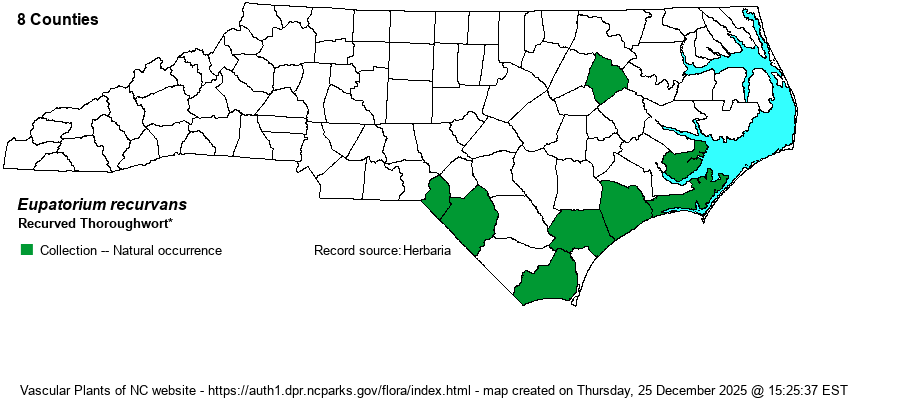| Section 6 » Family Asteraceae |
Show/Hide Synonym
| taxonName | relationship | relatedTaxonName | relatedTaxonRefText | relComments |
|---|
|
|
| Eupatorium recurvans | < | Eupatorium mohrii | Gleason and Cronquist (1991) | | | Eupatorium recurvans | < | Eupatorium mohrii | Flora of North America (1993b, 1997, 2000, 2002a, 2002b, 2003a, 2004b, 2005, 2006a, 2006b, 2006c, 2007a, 2009, 2010) | | | Eupatorium recurvans | < | Eupatorium mohrii | Kartesz (1999) | | | Eupatorium recurvans | < | Eupatorium mohrii | Vascular Flora of the Southeastern States (Cronquist 1980, Isely 1990) | | | Eupatorium recurvans | < | Eupatorium mohrii | Wunderlin & Hansen Flora of Florida (3) | | | Eupatorium recurvans | < | Eupatorium recurvans | Radford, Ahles, and Bell (1968) | (also see E. anomalum and E. mohrii) | | Source: Weakley's Flora |
|
| Author | Small | |
| Distribution | Mostly the southern Coastal Plain; not known from the Sandhills proper. As mentioned below, the species was moved in recent decades to E. mohrii. However, Weakley (2024) and a few other references have pulled out this "renamed" recurvans from the much more common Mohr's Thoroughwort (E. mohrii). Thus, the many dozens of specimens in SERNEC listed as E. recurvans are probably mostly now E. mohrii, and all NC specimens of Recurved Thoroughwort need to be checked for identification, including the ones mapped below.
Coastal Plain, NC to southern FL. | |
| Abundance | Apparently uncommon along the southern coast, but presumably quite rare farther inland, to Edgecombe and Scotland counties. As most of the records formerly named as this species now appear to be Mohr's Thoroughwort, the abundance of this species is unsettled. It is a Watch List species, though the editors suggest a State Rank of S2? instead of the NCNHP's S1?. | |
| Habitat | Dry to mesic Longleaf Pine-Wiregrass uplands and savannas. Whereas E. mohrii seems to be essentially a wetland species, this species occurs in more mesic soils, though it does occur in savannas. |
| Phenology | Flowering and fruiting August-October. | |
| Identification | This species is very similar to Mohr's Thoroughwort -- having narrowly elliptic leaves about 6-8 mm wide, though not necessarily recurved; see that species account for identification details. Weakley (2018) says that this species often erectly branches from near the base, as opposed to not branching near the base in E. mohrii; and this species is only 1-2 feet tall, as opposed to 3-4.5 feet tall in E. mohrii. Thus, this species is somewhat "bushy" because of the multiple near-vertical stems coming from the base, and it barely reaches to knee or mid-thigh height. The Flora of the Southeastern United States website contains three excellent photos of the plant growth form, leaves, and habitat. | |
| Taxonomic Comments | Older references did name the species as E. recurvans, but later renamed it as E. mohrii. All references now recognize E. mohrii, and only some now recognize the "new" E. recurvans from it. Neither NatureServe nor iNaturalist recognize this name, and the species is still considered a part of E. morhii. Thus, review of iNaturalist photographs for the presence of the "new" E. recurvans is very difficult if not impossible, as any photos are merged into this latter species name and map.
| |
| Other Common Name(s) | Recurved Eupatorium, Recurved Boneset | |
| State Rank | S1? [S2?] | |
| Global Rank | G3G4Q | |
| State Status | W7 | |
| US Status | | |
| USACE-agcp | | |
| USACE-emp | | |

